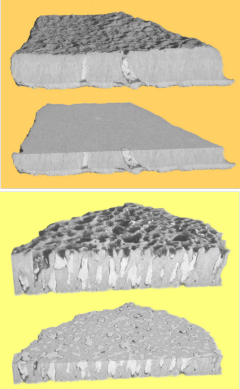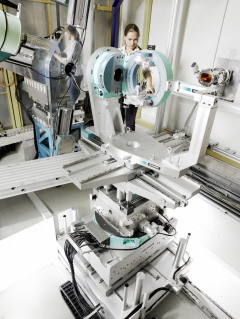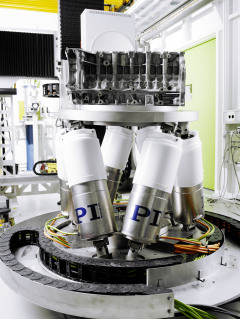X-ray experiment reveals kinship of 150 million-year-old dinosaur eggs
A team of international research scientists have carried out some very detailed synchrotron radiation examinations on fossils, using two beamlines of the Helmholtz Zentrum Geesthacht (HZG) in Hamburg. The results regarding the evolution of dinosaur eggs were recently published in Nature Scientific Reports.

Thanks synchrotron radiation differences in the structure of fossil eggs could be detected. Below, yellow: The 150-million year old porous shells from Lourinhã, top (orange), the "only" 80 million years old eggshells. [Image: R.M. Martins]
Dinosaur eggs, whether with or without embryos, are extremely rare. There are only a few excavation sites worldwide. One of these is situated north of the Portuguese capital of Lisbon, in Lourinhã. The fossil eggs, which were discovered there, in a 150 million-year-old rock layer, originate from the so-called carnivorous Theropod species. This species of prehistoric animal includes the T-Rex, for example, and also the ancestors of our present-day birds.
Dr. Norbert Schell, a scientist at the Helmholtz Zentrum Geesthacht, with responsibility for the High Energy Materials Science Beamline (HEMS) at the PETRA III storage ring in the German Electron Synchrotron (DESY), explained: “the available material is so precious, that every effort must be made not to damage it during synchrotron radiation examinations“.
Why is synchrotron radiation used?
Synchrotron radiation is generated when charged particles such as electrons, for example, circulate in an accelerator ring. When the electrons, travelling at almost the speed of light, are directed around the curves by magnets, they always lose a part of their energy by emitting a high intensity light beam. This light beam is an ideal tool for scientists. The reason being that in the X-ray area, the light from the accelerator is up to a million times brighter than the X-ray equipment in a doctor’s practice. As the wavelength of this radiation is significantly smaller than that of visible light, nanometer-sized fine structures, and in some cases even atoms, can be detected.
As Dr. Norbert Schell explains, “With our scientific methods and instruments, we were able to X-ray the fossil eggs in a non-destructive way and provide information about structure, composition and porosity with details down to micrometer range. These experiments were a very special experience for us. We don’t normally get to see 150 million-year-old samples. It is more usual for us to X-ray modern materials such as motors, new kinds of weld seams or superconductors“.
Diffraction und tomography provide a new perspective on dinosaur evolution

At the HARWI II beamline, the first experiments with the fossils were carried out. Photo: HZG/ Christian Schmid
The dinosaur researchers from Portugal and Texas became aware of the innovative test procedures at the Helmholtz Zentrum Geesthacht through the materials researcher Dr. Rui M. Martins. This Portuguese scientist has been working closely with Helmholtz research scientists for some time now. With the dinosaur experiment, he was one of the first external users of the HEMS beamline, which came into operation in 2010. At that time the egg shells were X-rayed with only a 100 micrometer size beam, with high X-ray energy, in order to examine their structure and chemical composition and that of the nest surroundings by means of diffraction images. The results suggest that their breeding behavior was similar to that of sea turtles today. These bury their eggs in sand pits in order to protect them from predators during the incubation and hatching period.
The subsequent tomography experiments were carried out on the HARWI II beamline of the Helmholtz Zentrum Geesthacht, at the DORIS storage ring in Hamburg. An approx. five millimeter small fragment of the dinosaur egg was hereby turned to various positions in the synchrotron beam and the absorption of the beam determined.
Computer-based evaluations of a large number of such tomography cross sections enabled subsequent visualization of the pore structure of the egg shells and also the bone remains of the embryos with a resolution of only 6 micrometers. In comparison: a human hair has a diameter of approx. 50 micrometers. Dr. Felix Beckmann, responsible HZG tomography expert at the HARWI II beamline, commented: “For us these images were not so different from those which we otherwise take of amphibian heads or cracks in weld seams”.
On the basis of these investigations, the research team was able to close a gap in the genealogy of the dinosaur, as they discovered which properties of the egg shell and bones had been passed on from ancestors and which had been newly acquired in the course of evolution. The scientists established that the examined eggs do indeed look different from the 80 million-year-old eggs of the dinosaurs which succeeded them. By means of these very detailed images, research scientists were able to perceive for the first time that the egg surfaces show more irregular ribs than those of younger eggs.
Moreover, it could be determined that the older eggs only have a single outer layer und a large number of pores and are thus similar to crocodile eggs. The younger Theropod eggs have two to three outer layers in the same way as the birds’ eggs of today.
GEMS – scientific attention to detail

Experiments with large components can be carried out at the HEMS beamline, pictured here: an engine block. Photo: HZG/ Christian Schmid
Synchrotron radiation – a particularly brilliant X-ray beam – does not, however, only contribute to research in the field of fossils. The beamlines at the Helmholtz Zentrum Geesthacht are mainly used to analyze metals, plastics and biomaterials. These activities are bundled at the “German Engineering Materials Science Centre” (GEMS).
The Helmholtz Zentrum research platform provides research instruments for internal and external users from all over the world. As in the case of the dinosaur eggs, Helmholtz scientists do not only provide advice to users but also carry out scientific experiments and analyze results or provide tomography images. This was an unusual excursion into the evolution of dinosaurs for the research scientists of the Helmholtz Zentrum Geesthacht.
Daily routine has now already directed their attention towards matters regarding the materials of the future and how they can use their instruments, methods and know-how to contribute to finding solutions – whether for their colleagues in Geesthacht or for external and industrial users.
More Information
GEMS Website GEMS-Clip (Youtube)
Contact

